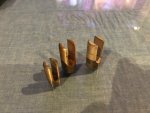- Joined
- Jul 4, 2008
- Messages
- 2,499
- Points
- 113
For some reason when I tried to repy to your message I get
"Seoul_lasers has chosen not to receive private messages or may not be allowed to receive private messages. Therefore you may not send your message to him/her.
If you are trying to send this message to multiple recipients, remove Seoul_lasers from the recipient list and send the message again."
Anyway yes the SXD does have thermal protection and when it goes of the unit goes on and off in 1 second intervals preventing damage to the driver. It should not throttle the current or dim the diode as you mentioned. Is it possible one of the connections was shorted something came in contact with a component on the driver. The worst fear I have is that the drivers regulation was bypassed and you got a full shot from the batteries which could make the diode go from fully lit to dimming out as it overheats from over current. Anyway if you can get some more pictures of the unit when you get it out that might leave a clue or if you can shoot it over to me and let me test it out. Did something in the setup change from the first tests to the run where it did this?
I fixed that PM issue and discovered that you were not in my contact list. The PM settings changed ( I changed this) due to the recent flood of spam I got from Vietnam.
Going back to the driver issue.
The first 2 tests were 2-5seconds on. Going up to 7 seconds is where this went south. Thats the only thing that changed. Length of time. I got a dimming from full power then a pop sound. (sounded like a regulator going off)
I got a strong smell of a component overheating and hot thermal epoxy.
I am going to remove the module from the host and get some pictures of it. hmm...
:thinking:
@ Euphonious Nonsense
I think perhaps in your situation that the lower heatsink (with the threads) needs a better connection to the top ( head of the host.) If you measure the resistance from the head of the host and the lower heat sink (with threads for the battery compartment) what do you get as a reading on your DMM (ohms)?
The other culprit might be the actual threads of the battery compartment (/tail clicky) may need a cleaning.
Test and get back to us.
Last edited:





